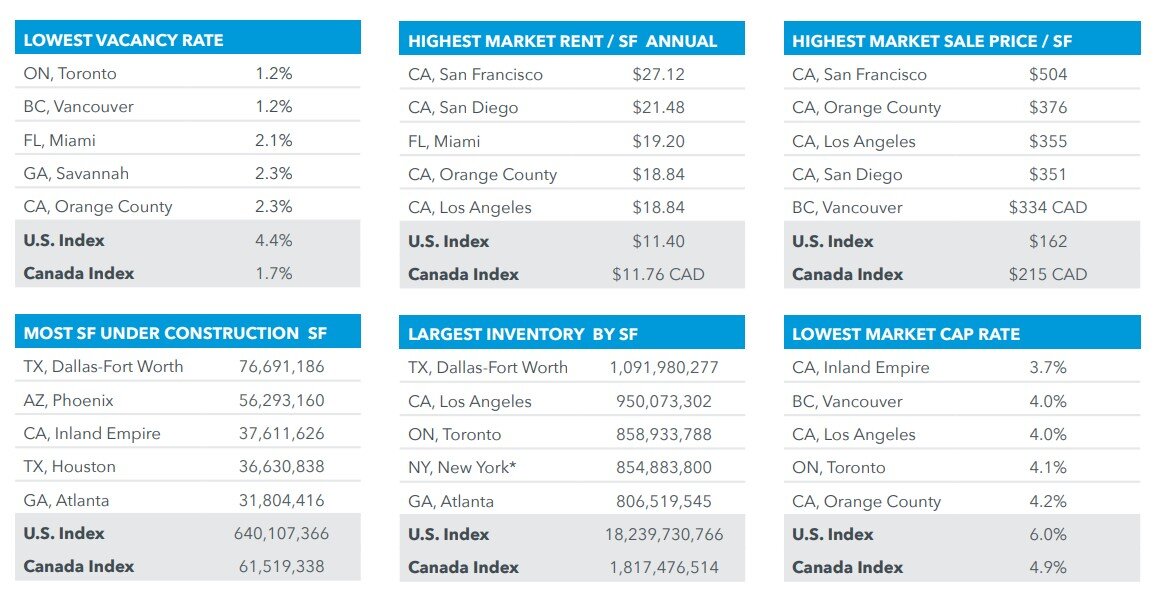Commercial Real Estate News

America's Industrial Market Experiences Sharp User Demand Declines in Early 2023
Commercial News » Los Angeles Edition | By Michael Gerrity | April 20, 2023 8:40 AM ET
According to new research by national commercial property broker Lee and Associates, there was a sharp first-quarter decline in U.S. tenant demand for industrial space as wholesalers and retailers reconsider their inventory levels out of caution over the economic outlook. Net absorption in the first quarter totaled 39.4 million SF, a 57% drop from the record set a year ago. Demand for Canadian industrial space in Q1, however, gained nearly 21% year over year. The overall U.S. vacancy rate settled at 4.4%, an increase of 40 basis points from the close of 2022, comfortably below the 7.3% market average over the last two decades. Vacant space at the end of March totaled 805.6 million SF, up 81.4 million SF from the previous quarter.
Lee and Associates further reports a potential pullback in consumer spending poses downside risks for 2023, onshoring of high-tech manufacturing will likely be a key driver of U.S. absorption from 2024-26. The federal government's 2022 passage of the CHIPS and Science Act, and the Inflation Reduction Act provided more than $400 billion worth of incentives for growth in U.S.-based high-tech manufacturing. Newly completed space in the first quarter totaled 120.3 million SF compared to 74 million SF delivered in the same period last year. The stock of U.S. industrial property is set to grow nearly 4% in 2023 for the fastest pace of supply growth in more than 30 years. Barring a severe shock to the U.S. economy and industrial leasing, the volume of space set for delivery likely will produce only a moderate increase in vacancy without tipping the market in the tenants' favor. Influencing long-term prospects, increased interest rates of the past two quarters and concern that the increased cost of new construction may exceed replacement cost have caused developers to pull back by up to 40% starting late last year. The recent slowing in net absorption is broad-based across most major markets. Los Angeles and Southern California's Inland Empire - with respective vacancy rates of 3.4% and 3.1%, similar to other coastal markets - notably have posted outsized increases in space availability in recent months. Otherwise, the construction pipeline of projects is barely enough to meaningfully ease the space shortages in the majority of coastal markets since the lockdown.
Imports have been declining at the national level since November. The slowing has been most pronounced at the Port of Los Angeles, where inbound cargo has been reduced by the Covid wave in China and risks of a strike by West Coast dockworkers. The potential strike has caused many importers to divert cargos to major East Coast ports, allowing East and Gulf Coast ports such as Newark, Savannah, Houston, Norfolk and Charleston to lead the U.S. in import growth since the Great Recession.
Lehigh Valley, Richmond, Tampa, Jacksonville, Detroit and Reno have bucked the national trend and record tightening availability since mid-2022, even among properties larger than 100,000 SF. U.S. and Canadian landlords in Q1 are expecting annualized 9.9% and 14.1% rent growth respectively. But those gains appear less likely to materialize as 2023's record levels of deliveries will see 250 million SF added in the second quarter and 650 million SF projected this year.
Sign Up Free | The WPJ Weekly Newsletter
Relevant real estate news.
Actionable market intelligence.
Right to your inbox every week.
Real Estate Listings Showcase
Related News Stories
Commercial Real Estate Headlines
- One Trillion Dollars of America's Commercial Property Loans Mature in 2025
- U.S. West Coast Dominates Self Storage Demand
- Phoenix, Orange County and Inland Empire Emerge as Leading U.S. Industrial Markets
- U.S. Mega Distribution Centers Leasing Activity Grew in 2024
- U.S. Commercial Borrowing to Increase to $583 Billion in 2025, Up 16 Percent Annually
- Demand for U.S. Life Sciences Space Spikes 28 Percent Annually in Late 2024
- Multifamily Property Sector in America Rebounding
- Asia Pacific Commercial Property Investment Spikes 23 Percent in 2024
- U.S. Commercial Property Market Primed for Growth in 2025
- Architecture Industry Sees Mixed Signals as 2025 Approaches
- Global Data Center Demand Spikes in 2025
- 2025 Prediction: U.S. Commercial Investment Recovery Expected to Gain Traction
- Holiday Retail Sales for 2024 to Hit Record $1 Trillion
- Tech, AI Industries Drive Largest Share of Office Leasing Activity in U.S.
- Commercial Real Estate Lending in U.S. Enjoys Strong Growth in Q3
- U.S. Multifamily Market Begins Recovery in Q3
- Commercial Investment in Japan Spikes 24 Percent Annually in Q3
- Despite Return-to-Office Mandates, U.S. Office Vacancies Continue to Rise
- PROPSIG Tech Startup Acquired by World Property Data
- U.S. Commercial Mortgage Debt Hits $4.7 Trillion in Q2 as Delinquencies Increase
- Hong Kong Class A Office Rents Continue to Downtick in Mid-Summer
- U.S. Office Landlords Tenant Concessions Decline for First Time in 4 Years
- U.S. Commercial Mortgage Originations Spike 27 Percent in Q2 Over Q1
- Phnom Penh's Commercial Office, Retail Markets Face Slowdowns in 2024
- Global Edge Data Center Market to Hit $300 Billion by 2026
- Commercial Property Transactions in Japan Dive 25 Percent Annually in Q2
- Delinquency Rates for U.S. Commercial Property Loans Downticks in Q2
- Megawarehouse Lease Deals in U.S. Increase in 2024
- Office Tenants' Flight to Quality Buildings Increases in 2024
- Commercial Lending in Japan Upticks 6 Percent Annually in Q1
- AI Driving Significant Global Data Center Growth in 2024
- Total U.S. Commercial Mortgage Debt Rises to $4.7 Trillion in Q1
- U.S. Commercial Mortgage Delinquencies Rise in Early 2024
- Asia Pacific Office Sector to Further Reprice Throughout 2024
- U.S. Retail Foot Traffic to Surpass Pre-Pandemic Levels by 2025
- Commercial Real Estate Lending in U.S. Slowed in First Quarter
- Japan Commercial Property Investment Volume Jumps 7 Percent in Q1
- Asia Pacific Commercial Property Investment Leads the World, Spikes 13 Percent
- Driven by High Rates, U.S. Commercial Lending Imploded 47 Percent in 2023
- After Two Year Slump, Prime Multifamily Metrics Uptick in U.S.






